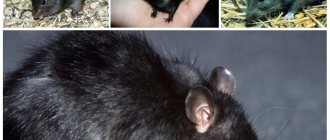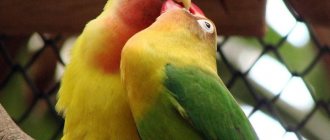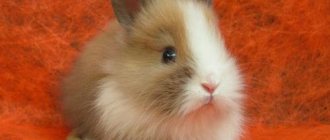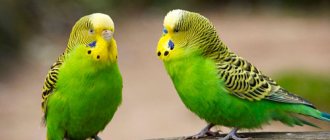How many years do chinchillas live?
Chinchillas differ from other rodents in their longevity: in favorable conditions, this animal can survive up to 30 years. Moreover, life expectancy in the wild and at home can be quite different: as a rule, in nature such an animal lives half as long as in favorable conditions next to a person.
Life in nature
In the wild, a chinchilla lives on average up to 10-12 years. As a rule, closer to the eleventh or twelfth year, the animal becomes less agile and fast, as a result of which it can easily fall into the clutches of predators.
A wild chinchilla can survive in conditions with sparse vegetation, as well as in places where there is little suitable food, water and secluded places in which to hide, such as rocky areas. However, such extreme living conditions contribute to a reduction in the lifespan of this animal.
Home conditions
Life expectancy in captivity directly depends on the conditions under which the animal is kept. With proper care and the right diet, a chinchilla can live about 25-30 years.
However, in unfavorable and uncomfortable conditions, which consist primarily of an incorrect diet, neglect to keep the animal’s cage clean, as well as poorly thought-out organization of the home, the pet is unlikely to overcome the eight-year mark.
Chinchillas have a specific life cycle.
Life expectancy of an animal in nature
Chinchillas naturally live in rocky areas, where threats lurk around every corner for the tiny creatures. Despite the fact that animals have learned to hide from danger in burrows, caves and under stones, attacks by predators (foxes, owls, wild cats) complicate the existence of chinchillas and shorten their lifespan.
To survive, animals gather in colonies, preferring to sleep during the day and stay awake at night. A well-developed cerebellum, sensitive vibrissae and large eyes help chinchillas fight the dangers of the wild and maintain the population. Fluffy babies feed on healthy plants containing vitamins, amino acids and antibiotics, and sometimes eat insects.
The special structure of the body, sense of smell and hearing cannot save furry rodents from another danger - infectious diseases that cause premature death. In natural wild conditions, most die due to infections after living only 10–15 years. If the animals do not die at the hands of hunters, attacks by predators or diseases, furry rodents can live 30 years in the wild.
Life cycle of a chinchilla
The life cycle of all animals of a given species is usually identical. Depending on a certain stage of the life cycle, the optimal weight of the pet is determined, as well as the products from which the animal’s diet is composed.
The main stages of a chinchilla's life cycle:
- birth. Newborn chinchilla puppies - from birth to the second week of life . Babies are usually born sighted, with teething and a little fur. They feed on milk;
- childhood. Small chinchillas - from 14 days after birth to 50 days of life. They feed on food, weighing about 200 grams. Babies begin to be separated from their mother 45-50 days after birth;
- puberty. The animal becomes an adult at 2 months, when growth and weight gain stop. At this time, it is important to provide the animal with a nutritious diet and maintain the pet’s health with proper nutrition;
- Maturity is reached by the animal at approximately 7 months. This period is usually marked by the birth of cubs, and the female can bear 2-3 litters per year;
- old age - from 17-20 years. At this stage, the pet needs food enriched with useful elements, a calm environment and attention from members of the household.
Pregnancy for a female chinchilla usually lasts about 3.5-4 months. One litter usually consists of 2-3 cubs. Sometimes up to 5 babies are born. Chinchillas do not lose their ability to reproduce until they are 15 years old.
This is interesting. The weight of a healthy baby chinchilla up to 1.5-2 months of age usually varies between 250-300 grams.
You need to clean your home at least once a week
What sounds do chinchillas make?
In nature, chinchillas live in groups and have developed a way of communicating with sounds. Their range ranges from a soft and quiet purr to a sharp whistle:
- mating rumbling calls of the male to mate;
- squeaking of babies - a demand for mother's attention or food;
- protest - sharp sounds that chinchillas make when quarreling or warning of danger;
- Chinchillas make very sharp and high-pitched sounds when angry, in a state of severe fright or when feeling pain.
How to extend the life of a chinchilla
The lifespan of an animal largely depends on nutrition, as well as on the conditions in which the pet lives. Genetics also plays an important role: some animals are susceptible to diseases and rather poor health, which does not allow the animal to reach old age.
The main factors influencing the lifespan of a rodent:
- a carefully selected diet that includes healthy foods, vitamins and minerals;
- temperature in the cage and in the room. It is important to avoid drafts, overheating and ensure that there is always fresh air and optimal temperature in your pet’s home ;
- maintaining cleanliness in the cage. It is advisable to clean your home at least once a week;
- physical activity of the animal. It is recommended to provide the rodent not only with bowls and a drinking bowl, but also with attractions and toys. In addition, it is advisable for the owner to walk with the pet around the apartment. At the same time, the animal must be under constant supervision;
- spacious safe cage. The animal's home should be large enough and comfortable, without sharp protrusions or any elements in which the pet could get stuck or get hurt ;
- calm environment and lack of stress;
- regular visual inspection of the animal, as well as paying attention to its mood and behavior. For example, lethargy and apathy may indicate stress or illness.
Is your chinchilla playful?
When examining your pet, you need to pay attention to the condition of the eyes, ears, nose and teeth. The coat should be free of bald spots, and breathing should be measured and calm. A sudden change in weight should also alert the pet owner and cause a visit to the veterinarian.
Worth knowing . The chinchilla is very sensitive to ambient temperature, so it is advisable to choose a place for the cage so that the pet is protected from both drafts and direct sunlight.
You should buy a chinchilla that is at least 2 months old.
Monitor your health
Diseases in chinchillas are mostly typical and if treated in the first stages, they do not pose any danger to life. It is necessary to constantly examine the chinchilla, weigh it and look at its activity. If the chinchilla becomes lethargic, drinks and eats less, then it is sick with something.
Common diseases of chinchillas
- Digestive diseases
- Teeth grow incorrectly, hooks form
- Metabolic disease
- Hypothermia or overheating
Most often, chinchillas die when the owners do not attach importance to diseases and believe that diarrhea or bloating will go away on its own. As a result, the chinchilla gets worse every day and if urgent measures are not taken, it will die.
Home treatment is most often done to save money, but without experience, it can only cause harm. Therefore, do not risk your animal and contact a veterinarian, who will usually make a diagnosis and prescribe treatment in one visit, which you can continue on your own.
Injuries
Getting injured in a cage is very difficult and extremely rare. Typically, chinchillas are injured due to human fault when they are allowed to walk around the apartment unattended or given to children to play with, who with careless movements and squeezing can accidentally break the bones of a fragile animal.
To avoid injury, you do not need to pick up the animal without its desire, i.e. Until you tame him, don't touch him. He will try with all his might to escape from your hands.
A chinchilla can get injured in a cage if it is very narrow. The animal loves to run and climb obstacles, and in a small cage it will constantly hit objects. It is also necessary to securely secure all ladders, shelves and hammocks so that chinchillas do not have the opportunity to fall and injure themselves.
Determining the age of a chinchilla
The age of an animal can be determined using various methods. In this case, you should focus on the appearance and weight of the animal. At the same time, the clearest differences are between young adolescents and mature animals. Every month the cub adds from 30 to 100 grams, and the weight of a one-year-old rodent usually reaches 600 grams.
Important. It is recommended to purchase a pet no earlier than 2 months old. At this age, it will be easiest for the animal to adapt to a new home and unusual environment.
By weighing
Weighing allows you to fairly accurately determine the age of your pet, but it is necessary to take into account the animal’s diet and its gender. Female chinchillas tend to be somewhat heavier than males and appear larger in appearance.
Age to weight ratio:
- newborns - 47-50 g;
- up to 1 month - 100 g;
- 1 month - 150-160 g;
- 2 months - 240 g;
- 4 months - 380 g;
- 5 months - 440 g;
- 7 months - 490-500 g;
- adult from 1 year old - 610-700 g.
Important. An adult animal usually weighs about 1-1.5 kg, so an animal with this weight is usually at least 1 year old.
Visual inspection
A visual inspection of the animal can give an idea of the rodent's age. Thus, young animals are usually more mobile and active. Cubs, as well as young individuals at the beginning of maturity, are very playful and curious, while mature pets prefer to lead a calmer and more measured lifestyle.
In addition to the animal’s behavior, it is worth assessing the condition and appearance of the pet’s physique, the color of the teeth and the structure of the muzzle:
- the physique of the cubs is noticeably smaller than the mature individuals. Instead of full fur, a light edge may appear;
- tooth color. The teeth of a baby chinchilla that feeds on milk are white, while the teeth of animals that feed on food and plant foods take on an orangish tint. The darker the animal's teeth, the older its age;
- structure of the muzzle. Pets up to six months old have a short, rounded muzzle. With age, the muzzle lengthens.
To correctly determine the age of an animal, it is recommended to take into account all factors together.
Paw inspection
The condition of a rodent's paws will help to accurately determine the age of the animal, and assessing the appearance of the paws is quite easy and simple with the naked eye.
The paws of a young pet are smooth, shiny and have a pinkish tint. With age, this part of the animal’s body becomes overgrown with calluses and covered with corns. The older and older the individual, the more calluses and keratinized areas appear on the paws. Most often, corns are yellowish-brown in color.
Chinchilla - description and external characteristics
In appearance, the chinchilla resembles a large squirrel (they weigh from 300 to 800 g, and males are smaller than females), but in terms of its method of movement it is more like a rabbit. They have very thick, thin and soft fur, large dark eyes and large ears. The ears are the only organ of chinchillas that helps reduce body temperature - they are covered with a dense network of capillaries.
The body length of chinchillas is from 22 to 38 cm, the tail is 10-17 cm. The hind legs are longer than the front legs, thanks to which their movement resembles the jumping of a rabbit. Number of toes: four on the hind limbs, five on the front limbs. The front legs can make grasping movements.
The number of teeth reaches 20, and they grow throughout life. Therefore, it is very important for chinchillas to be able to chew something.
Baby chinchillas have white teeth, but adult chinchillas have orange teeth.
Breeding chinchillas at home
Do not place a female and a male in the same cage at once; for the first two days, their cages should stand next to each other, and only after this period of time can they be placed together. If they are aggressive, they must again be placed in different cages and kept separately until they get used to each other. It is important that this must be done under the control of the owner, so that the animals do not injure each other.
The male reaches sexual maturity at the age of 8-9 months, and the female at 7-8 months. Please note that early pregnancy can worsen her health, even leading to death. The female's sexual cycle lasts 40-50 days, but during this period of time, estrus lasts only 3-4 days. The female carries the cubs for 105-110 days; experts recommend feeding the pregnant chinchilla with more vitamins during this period than with the usual diet. As a rule, one or two cubs are born, very rarely three. During the gestation period, it is necessary to separate the male from the female into another cage. The ability to reproduce lasts up to fifteen years.
It is quite difficult to find out whether a female is pregnant, but there are several signs by which conception can be determined:
- absence of heat;
- enlargement of the abdomen and a feeling of elasticity upon palpation;
- stable increase in body weight;
- increased appetite;
- presence of a plug in the cage;
- swelling of the nipples (at 7 weeks of pregnancy);
- the female is less active, more affectionate, but sometimes, on the contrary, she can show aggression.
Usually the birth of babies occurs at night or early in the morning. The entire birth process lasts no more than 2.5 hours, but if the baby is large, the birth may be delayed. As a rule, human help is not required, but if you notice that something is going wrong, it is better to call a veterinarian, otherwise the mother may die. Difficult births occur only in young and injured females.
Tips and Considerations
Unlike other rodents such as hamsters, mice and guinea pigs, chinchillas live much longer as pets. And this is important to consider because owning a chinchilla can be a potentially 20-year commitment. This means that all this time you will need to clean the cage, fill the water bowl, and buy food. And a lot of things besides this: bedding, toys, bowls, games, organization of care when you are away. And also remember that ideally chinchillas should be kept in at least pairs, so you may be caring for more than one chinchilla.
Is it possible to train a chinchilla to go to the litter tray?
Chinchillas are very smart and learn quickly. It is very easy to train them to go to the litter box: place it in the cage in the place where the animal usually goes to the toilet, you need to remove all the bedding and wipe the floor of the cage with lemon. The chinchilla will immediately understand what needs to be done.
Tray
The second method: at first allow the animal to go to the toilet on the entire bedding at the bottom of the cage, but gradually reducing it every day. When a small patch remains, replace it with a small tray. The main thing is to change the bedding every day so that the cage is always dry.











